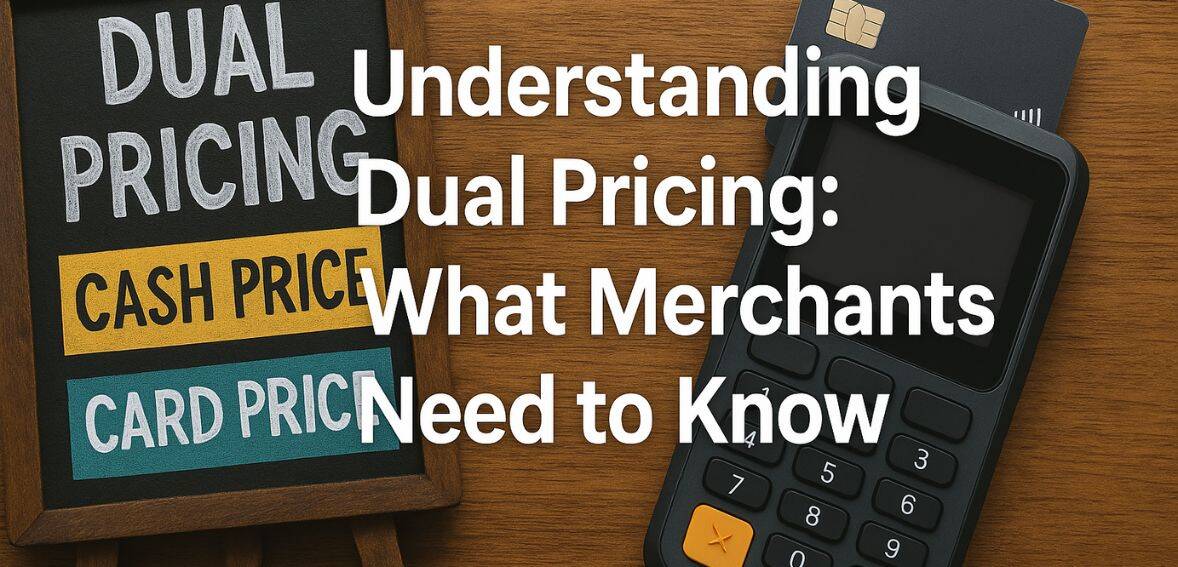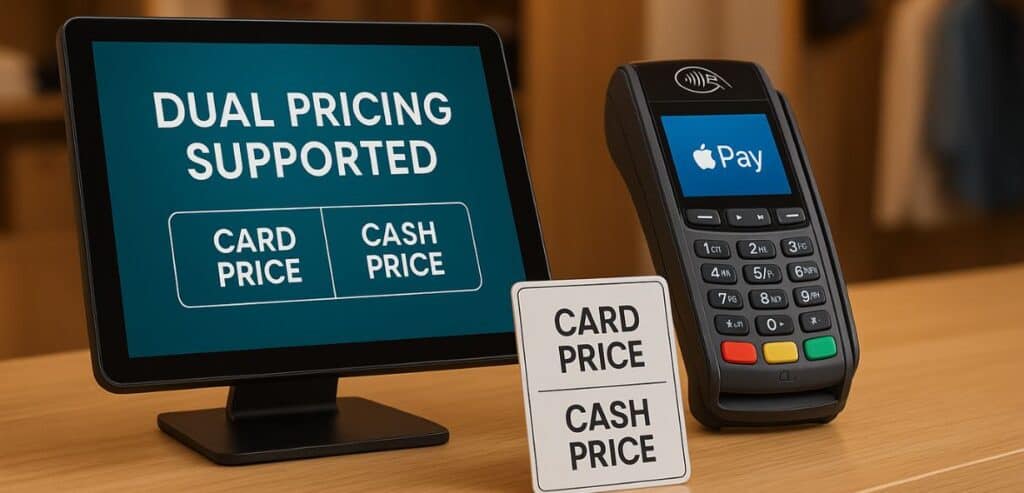
By Phoebe Davis June 12, 2025
In recent years, profit margins have been squeezed by rising credit card processing fees, particularly for small and medium-sized businesses. By allowing retailers to show a slightly higher price for cardholders and a lower price for cash payments, dual pricing has become a very attractive option. Customers who pay with cash are rewarded, and the cost of accepting cards is openly covered, rather than penalized. In addition to providing transparency, dual pricing gives businesses financial security, empowers customers, and fosters trust.
What Dual Pricing Looks Like in Practice

Imagine a local cafe where the well-known latte is clearly listed with two prices: $5.00 for cash payments and $5.15 for card payments. Both amounts are displayed clearly on the terminal at the point of sale, and customers choose the payment option that works best for them. That additional 15 cents is not profit padding; rather, it represents processing costs. In order to ensure compliance with card brand regulations, merchants must display prices on receipts as well as in-store.
As long as communication and signage are clear, this model complies with North American legal requirements. Dual pricing may show up for online retailers as “$100 cash (ACH) / $103 card” options at the point of sale. Customers are reassured and payment options are clearly distinguished by this type of transparency, which also preserves profitability without requiring the use of any particular payment method.
The Financial Impact and Transparency
Merchants are affected when processing fees range from 1.5% to 3% or higher. Customers who opt for dual pricing bear the additional expense of accepting cards. Payment processor reports indicate that consumers value the choice and are aware that it comes at a minor cost. Dual pricing adds clarity in addition to protecting revenue. Consumers gain trust when they understand why card transactions are more expensive. Merchants reward cash payments and respect the convenience of card users by offering transparent value choices in place of unexpected fees.
Challenges and Mitigation

Dual pricing has advantages, but it can also raise issues. Even when there were cash alternatives, consumers expressed dissatisfaction with paying more for cards in certain surveys. Merchants must train employees and post clear signage outlining the price differences in order to avoid negative feedback. Some cafés have quick discussions such as “Are you paying with cash today? You receive a small discount, making the cost advantageous.
Another important factor is legal compliance. American Express, Visa, and MasterCard restrict the way dual-pricing can be shown, and surcharges are limited to the cost of processing the card. Merchants must make sure that the cash price is never displayed as the listed price while card users see a surcharge added later, and that terminals, menus, and receipts all match. Dual-pricing may not be supported by older POS systems, necessitating technological upgrades.
But modern terminals and updates from major processors now make implementation fairly seamless.
One-Column Quick System Guide

Use this to provide a brief, useful introduction before the conclusion:
- Make sure the prices on your POS terminals can show both cash and card prices at the same time.
- All pricing that is visible (menus, tags, checkout) should be updated to accurately reflect dual-pricing formats.
- Train employees to positively explain the rationale behind dual pricing (“Discount for cash helps us stay efficient”).
- Keep an eye on changes in payment methods and respond by modifying pricing tiers or messaging.
- Observe brand guidelines: Visa and MasterCard limit price changes at actual processing expenses.
- To make sure they understand and accept, get feedback from customers on a regular basis.
Real‑Life Examples That Work
Measurable advantages are reported by companies in the retail, restaurant, and service sectors. An improved point-of-sale system caused 40% of transactions in one vape shop to be made in cash, significantly lowering monthly card fees. By providing a cash discount and simplified signage, a small boutique was able to save more than 30% a year. Without disturbing customers, even repair shops and salons report higher profits. When restaurant owners use dual pricing, they frequently discover that after a few visits, patrons understand the arrangement—especially if the discount is sincere and presented as a benefit rather than a drawback. This openness fosters goodwill among customers rather than dislike.
Dual Pricing vs. Surcharging
Dual pricing and surcharging are perceived differently by consumers, despite their similarity in practice. Surcharging adds a cost at the point of sale, which may appear punitive. In contrast, dual pricing positions the card as a convenience with a marginally higher price and sets the cash rate as the default.
In the United States, surcharging is prohibited in some states, but dual pricing is permitted in all 50. This minor distinction is reinforced by regulatory frameworks. Card networks restrict surcharges to processing expenses and require clear disclosures. Dual pricing stays comfortably within the bounds of compliance while avoiding the appearance of punishment.
Psychological and Loyalty Effects
Dual pricing appeals to the innate psychology of the consumer. Instead of feeling penalized for paying more, people frequently feel rewarded for paying less. Goodwill is increased when a cash discount is presented as a “thank you for helping us reduce costs.” Support for small businesses and repeat business can be improved by this emotional connection.
However, retailers need to be prepared for potential issues, such as clients who no longer carry cash or those who believe the model unfairly penalizes them. Simple signage, staff training to kindly explain the system, and reminding customers of the mutual benefits of the cash discount are all important components of clear communication.
Techier Tools Supporting Dual Pricing

Dual-pricing support is integrated into contemporary point-of-sale systems such as Dejavoo, Valor Paytech, and Lifelong Merchant Services. These solutions, along with tools like virtual terminals, eliminate the need for manual adjustments and ensure seamless pricing updates within the software. Businesses can monitor how many customers select each payment method and how margins change from month to month with the use of reports. Invoicing platforms and plugins for e-commerce automatically compare ACH and card prices. This enables retailers to divide up payments and preserve long-term accounting clarity. Dual pricing becomes not only possible but also profitable and data-driven as systems get smarter.
How Dual Pricing Affects Business Reputation and Customer Relationships
Any company’s reputation is a sensitive asset that is difficult to build and is easy to damage. When contemplating dual pricing, retailers frequently consider the potential effects on customer relations, particularly if the change is interpreted as an additional expense or new fee. The truth is, though, that the way dual pricing is explained makes a huge difference.
There is typically little opposition from companies that embrace it openly and teach their employees to explain it as a benefit of utilizing cost-effective payment methods. Indeed, a lot of consumers value the candor and are more inclined to patronize nearby companies when they believe they are receiving fair treatment.
In the retail and service sectors, word-of-mouth marketing is still very important. Customers quickly adjust when dual pricing is used with obvious signage and a customer-first approach. Many customers are already aware that credit card fees reduce the profits of small businesses, particularly those who have previously seen cash discounts or card minimums at independent stores.
Maintaining goodwill can be achieved with a straightforward, polite explanation, such as “we’re offering a lower price for cash to keep things affordable for everyone.” Businesses can also lessen surprises and gain recognition for their transparency by being proactive in their outreach, such as by sharing the policy on receipts, posting brief announcements on social media, or providing explanations on their website.
These initiatives strengthen a merchant’s dedication to ethical business practices and present dual pricing as an option rather than a punishment. In the end, how well companies educate their customers—both in-person and online—determines how they view this model.
Legal Considerations and Regional Variations in Dual Pricing Compliance
Even though dual pricing is permitted by federal law in Canada and all 50 U.S. states, merchants still have to deal with complex legal frameworks that differ slightly depending on the jurisdiction and payment network policies. The fundamental idea behind the model is to give customers a discount for paying with cash, which is seen more favorably than surcharging, which involves adding fees to the total at the time of payment.
In general, the presentation of the prices determines whether dual pricing is legal; both the cash and card prices must be shown upfront, free of any last-minute adjustments or hidden markups. Visa and Mastercard, for instance, mandate that the price difference must be at least as much as the actual cost to the merchant of processing the card transaction.
Even if done accidentally, overcharging can result in fines, chargeback disputes, or merchant account audits. Business owners should periodically check that their pricing, fees, and processing contracts reflect actual costs in order to maintain compliance. This is especially true when handling sensitive matters like ACH disputes, where regulatory precision and record-keeping are essential.
Dual pricing features that automatically modify receipts, tax computations, and back-end reporting in compliance with regional and brand-specific regulations are integrated into the majority of modern point-of-sale (POS) providers. Nevertheless, before implementing a new pricing strategy, merchants should still speak with their legal counsel or merchant services provider.
Dual pricing has become a clever strategy to encourage consumers to use domestic, less expensive payment methods in Canada, where Interac and EFT systems provide less expensive debit alternatives. In addition to shielding themselves from legal risk, merchants position themselves as knowledgeable, reliable, and professional in the eyes of their clients by coordinating their pricing strategies with regulatory frameworks and payment network regulations.
Conclusion
Dual pricing serves as a link between profitability and transparency and is more than just a pricing strategy. Merchants can build consumer trust, promote thoughtful payment methods, and preserve margins without increasing listed prices by providing clear options. Improved cash flow, lower card processing costs, and increased customer loyalty are some advantages.
However, consistent messaging, unambiguous signage, dependable technology, and continuous compliance monitoring are essential for success. When used carefully, dual pricing transforms from a defensive strategy into a growth tactic, enabling retailers to prosper in a market where every dollar counts.
Dual pricing is beginning to be used by both Canadian and American retailers, and early adopters report higher margins without sacrificing customer loyalty. Given that consumer budgets are getting tighter and economies are still recovering, dual pricing’s implied fairness and clarity can work to your advantage.
Merchants who embrace strategy and transparency will be at the forefront in 2025. In addition to providing a financial buffer, dual pricing serves as a reminder that integrity pays off in the business world.